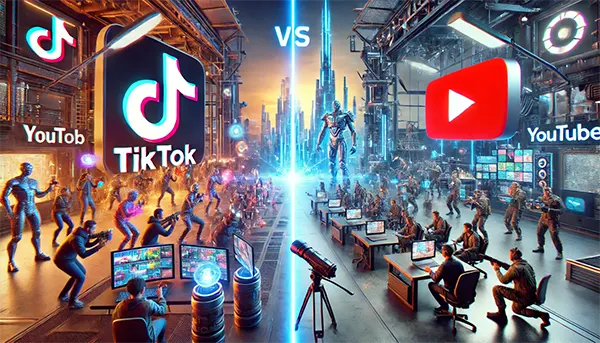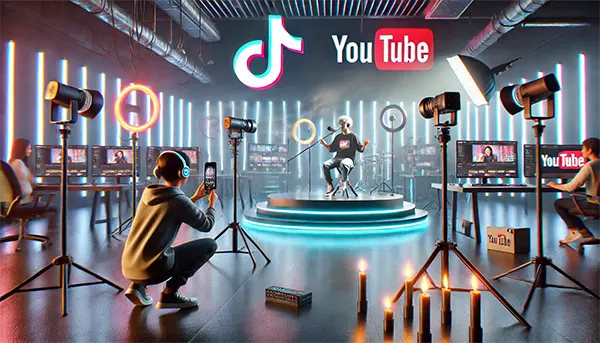TikTok vs. YouTube: Which Platform Wins the Video Battle in 2025?

In 2025, the battle between TikTok and YouTube continues to shape the video content landscape. With evolving algorithms, new monetisation models, and shifting user preferences, content creators must adapt to stay ahead. Which platform will dominate the digital stage this year?
How TikTok’s Algorithm Is Changing in 2025 and Why It Matters
TikTok’s algorithm has always been a game-changer in the social media world, and in 2025, it’s taking a more personalised and interactive approach. The new AI-driven content curation system prioritises user engagement metrics beyond just watch time and likes. It now considers dwell time, content rewatch rates, and real-time interactions to refine video recommendations.
One of the most significant updates is the introduction of “Interest Clusters,” where the algorithm groups users based on nuanced content preferences rather than broad categories. This ensures that creators can reach their exact target audience more efficiently, leading to higher engagement rates.
For influencers and marketers, this shift means that generic viral trends may no longer be enough. Instead, creators must produce content that fosters deeper engagement through storytelling, authenticity, and interactive features such as polls and live Q&A sessions.
Does TikTok Threaten YouTube’s Video Content Monopoly?
For years, YouTube has been the undisputed king of long-form video content. However, with TikTok’s growing emphasis on longer videos (now up to 10 minutes) and advanced monetisation tools, YouTube’s dominance is being challenged. TikTok’s user base continues to expand across demographics, attracting both younger audiences and older users who previously favoured YouTube.
YouTube still holds an edge in terms of educational and in-depth content, as its format allows for detailed explanations and comprehensive storytelling. However, TikTok’s ability to capture audience attention through shorter, dynamic content is reshaping how people consume videos. Many creators now cross-post their content on both platforms to maximise reach.
The biggest question for 2025 is whether TikTok’s advancements in searchability and AI-driven discovery will rival YouTube’s SEO-based recommendation system. If TikTok succeeds in enhancing its search functions and indexing capabilities, it could pose a serious threat to YouTube’s status as the go-to platform for video discovery.
New Promotion Strategies on TikTok and YouTube in 2025
With both platforms competing for creators and advertisers, the promotional strategies in 2025 have evolved. TikTok has introduced “Premium Boosts,” a paid tool allowing creators to amplify their best-performing content to niche audiences. This feature operates similarly to YouTube’s paid ad placements but focuses on engagement-driven exposure.
Meanwhile, YouTube Shorts continues to receive algorithmic priority. YouTube’s AI now integrates Shorts performance with traditional long-form videos, meaning creators who excel at both formats benefit from increased visibility. This makes hybrid content strategies—mixing short clips with long-form explanations—more important than ever.
Another key trend is the shift toward interactive and community-driven promotions. TikTok’s Live Shopping feature has become a mainstream tool for e-commerce, while YouTube has improved its community tab, allowing influencers to engage audiences through polls, updates, and behind-the-scenes content.
Which Platform Offers Better Monetisation in 2025?
Monetisation remains a major factor in the TikTok vs. YouTube debate. In 2025, YouTube still leads in direct ad revenue, with its established YouTube Partner Programme providing stable income for creators through ads, memberships, and sponsorships.
However, TikTok is rapidly catching up with its expanded Creator Fund 2.0, which offers higher payouts for viral videos. Additionally, TikTok’s in-app tipping, brand deals, and live gifting have created multiple income streams for influencers, making it easier for emerging creators to monetise their content.
While YouTube offers a more predictable income model, TikTok provides more diverse and immediate revenue opportunities, making it particularly attractive for influencers looking for rapid growth and financial flexibility.

The Future of Video Content: Which Platform Will Dominate?
As both platforms continue to innovate, predicting the ultimate winner of the video battle remains challenging. YouTube’s strength in searchability, long-form content, and monetisation stability gives it a strong foundation. Meanwhile, TikTok’s cutting-edge AI, short-form appeal, and interactive features keep it ahead in audience engagement.
One possible outcome is a hybrid approach where creators utilise both platforms strategically. YouTube may remain the top choice for in-depth educational content, while TikTok thrives as a hub for trend-driven, quick-consumption videos.
Ultimately, the winner in 2025 will be determined by how well each platform adapts to changing creator needs and audience behaviours. As both platforms evolve, content creators will need to stay agile and leverage the best of both worlds.
Final Thoughts: Choosing the Right Platform for 2025
For creators, the choice between TikTok and YouTube depends on their goals. Those seeking a structured revenue model and long-form content opportunities may still favour YouTube. Meanwhile, influencers focused on virality, audience interaction, and diversified monetisation may find TikTok more rewarding.
Brands and advertisers must also consider where their target audience spends the most time. With Gen Z and millennials heavily engaged on TikTok and older demographics still favouring YouTube, a balanced multi-platform strategy may be the best approach in 2025.
Whichever platform prevails, one thing is clear: the video content industry is evolving faster than ever, and creators must stay informed and adaptable to thrive in this competitive landscape.
